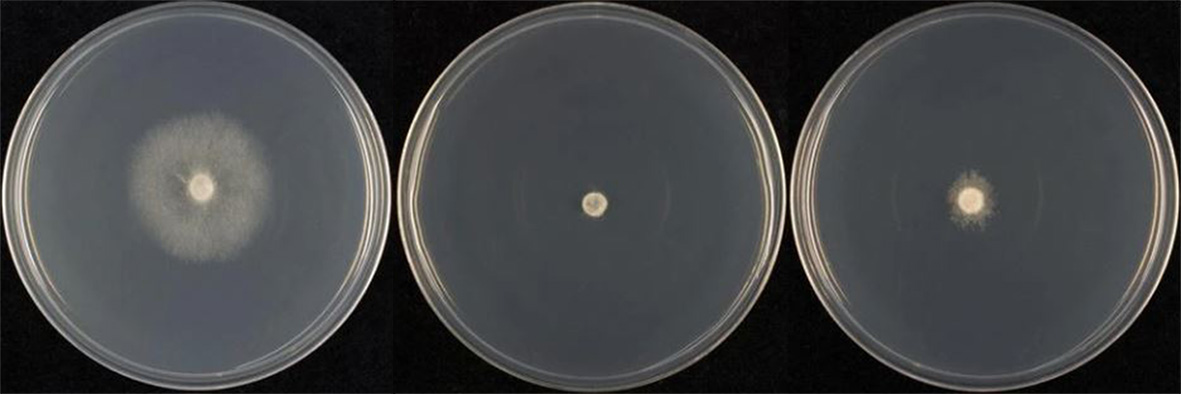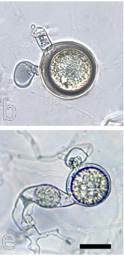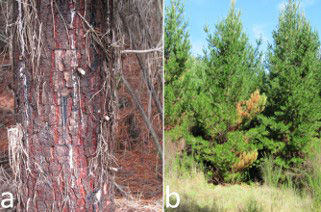Phytophthora aleatoria
|
Phytophthora spp. in subclade 1a: portion of the seven-loci ML phylogeny featuring the type cultures of 212 described species (by T. Bourret). Notice the position of P. aleatoria Ex-type NZFS 4037. Gloria Abad, USDA S&T.
|
|
Phytophthora spp. in subclade 1a: Morphological Tabular key (PDF) and Tabular key legends (PDF) in IDphy2 KEY SECTION. Notice the data of P. aleatoria Ex-type NZFS 4037. Gloria Abad, USDA S&T.
|
|
colony morphology after 7 d growth at 20ºC on V8A, MEA, and PDA agar (from left to right) |
|
persistent and caducous, papillate, predominantly ovoid and limoniform sporangia — scale bar = 20µm |
|
oogonia with smooth walls containing aplerotic oospores; antheridia can be both amphigynous and paragynous — scale bar = 20µm |
|
stem bleeding cankers associated with P. aleatoria on five-year-old Pinus radiata trees growing in Motueka Gorge, in the Nelson region; and b branch die-back with a canker on a two-year-old P. radiata tree in Nelson, associated with Phytophthora aleatoria |
Name and publication
Phytophthora aleatoria P.M. Scott, R. McDougal & P.M. Taylor (2019)
Scott P, Taylor P, Gardner J, Puértolas A, Panda P, Addison S, Hood I, Burgess T, Horner I, Williams N, and McDougal R. 2019. Phytophthora aleatoria sp. nov., associated with root and collar damage on Pinus radiata from nurseries and plantations. Australasian Plant Pathology, 48 (4): 313–321.
Corresponding author: Peter Scott; peter.scott@plantandfood.co.nz
Nomenclature
Mycobank
MB830076
Etymology
from Spanish “aleatorio”, meaning random, fortuitous, casual, accidental, referring to the sporadic variable disease expression
Typification
Type: NEW ZEALAND (AOTEAROA), Nelson, isolate from a two-year-old Pinus radiata seedling. Collected by Rod Baigent, NZFS 4037 (live culture and dried culture on V8A medium, New Zealand Forest Research Mycological Herbarium, Rotorua, New Zealand).
Ex-type: living culture preserved in a metabolically inactive state as NZFS 4037 (New Zealand Forestry Service Culture Collection)
Sequences of ex-type in manuscript: ITS MK282209, β-tubulin MK294172, cox1 MK294177
Ex-type in other collections
(ET) NZFS 4037
Molecular identification
Voucher sequences for barcoding genes (ITS rDNA and COI) of the ex-type (see Molecular protocols page)
Phytophthora aleatoria ITS rDNA, COI
Voucher sequences for Molecular Toolbox with seven genes (ITS, β-tub, COI, EF1α, HSP90, L10, and YPT1
(see Molecular protocols page) (In Progress)
Voucher sequences for Metabarcoding High-throughput Sequencing (HTS) Technologies [Molecular Operational Taxonomic Unit (MOTU)]
(see Molecular protocols page) (In Progress)
Sequences with multiple genes for ex-type in other sources
- NCBI: Phytophthora aleatoria
- EPPO-Q-bank: Phytophthora aleatoria
- BOLDSYSTEMS: Phytophthora aleatoria
Position in multigenic phylogeny with 7 genes (ITS, β-tub, COI, EF1α, HSP90, L10, and YPT1)
Clade clade:
a taxonomic group of organisms classified together on the basis of homologous features traced to a common ancestor
1a
Genome sequence
Phytophthora aleatoria strain ex-type NZFS4037. Accession genome NZFS4037v1 reference, BioProject, PRJNA687640, University of Exeter (2021)
Morphological identification
Colonies and cardinal temperatures
Slow growing species and uniform without a pattern on V8A, MEA, and PDA. Minimum growth temperature 4°C, optimum 20°C, and maximum 25°C.
Conditions for growth and sporulation
SporangiaSporangia:
sac within which zoospores form, especially when water is cooled to about 10°C below ambient temperature; in solid substrates, sporangia usually germinate by germ tubes
are produced in water cultures (non-sterile pond water) and not observed in solid media. OogoniaOogonia:
the female gametangium in which the oospore forms after fertilization by the antheridium
common in single culture.
Asexual phase
SporangiaSporangia:
sac within which zoospores form, especially when water is cooled to about 10°C below ambient temperature; in solid substrates, sporangia usually germinate by germ tubes
were papillatepapillate:
pertaining to the production of a distinct papilla at the distal end of the sporangium (cf. nonpapillate and semipapillate)
, mostly persistentpersistent:
pertaining to sporangia that remain attached to the sporangiophore and do not separate or detach easily (cf. caducous)
(some caducouscaducous:
pertaining to sporangia that become dislodged readily (i.e. deciduous) and separate from the sporangiophore (cf. persistent)
sporangia were observed), and predominantly ovoidovoid:
egg-shaped, with the widest part at the base of the sporangium and the narrow part at the apex
in shape with no proliferationproliferation:
formation of a sporangium within an empty sporangium that has previously emitted zoospores (internal or nested) or after the sporangiophore has emerged from the empty sporangium (external)
. SporangiaSporangia:
sac within which zoospores form, especially when water is cooled to about 10°C below ambient temperature; in solid substrates, sporangia usually germinate by germ tubes
averaged 31.7 x 23.3 µm (overall range 16.6–55.3 x 12.6–39.2 µm).Sporangiophores simple. Hyphal swellings present. ChlamydosporesChlamydospores:
an asexual spore with a thickened inner wall that is delimited from the mycelium by a septum; may be terminal or intercalary, and survives for long periods in soil
absent.
Sexual phase
Homothallic. OogoniaOogonia:
the female gametangium in which the oospore forms after fertilization by the antheridium
had smooth walls and size ranged from 24–45.6 µm; OosporesOospores:
zygote or thick-walled spore that forms within the oogonium after fertilization by the antheridium; may be long-lived
apleroticaplerotic:
pertaining to a mature oospore that does not fill the oogonium; i.e. there is room left between the oospore wall and oogonium wall (cf. plerotic)
, globoseglobose:
having a rounded form resembling that of a sphere
, size ranged 20.8–39.1 µm, often aborting before the formation of the oosporeoospore:
zygote or thick-walled spore that forms within the oogonium after fertilization by the antheridium; may be long-lived
wall. AntheridiaAntheridia:
the male gametangium; a multinucleate, swollen hyphal tip affixed firmly to the wall of the female gametangium (the oogonium)
both amphigynousamphigynous:
pertaining to the sexual stage in which the antheridium completely surrounds the stalk of the oogonium (cf. paragynous)
and paragynousparagynous:
pertaining to the sexual stage in which the antheridium is attached to the side of the oogonium (cf. amphigynous)
.
Most typical characters
Phytophthora aleatoria is a sister species to P. catorum and P. hedraiandra in cladeclade:
a taxonomic group of organisms classified together on the basis of homologous features traced to a common ancestor
1a, and morphological features overlap. The most distinguishing features are the slower growth rate and optimum and maximum temperature for growth.
Additional specimen(s) evaluated
New Zealand, Nelson, from a two-year-old Pinus radiata seedling. 2014, Rod Baigent, NZFS 4037; 1999, NZFS 351; Hawkes Bay, 2000, NZFS 451; Bay of Plenty, 2008, NZFS 3022; 2011, NZFS 4037
Hosts and distribution
Distribution: New Zealand
Substrate: stems, roots
Disease note: resin bleeding, cankers, discoloured foliage, and sometimes mortality in small seedlings
Host: Pinus radiata
Additional references and links
- SMML USDA-ARS: Phytophthora aleatoria
- EPPO Global Database: Phytophthora aleatoria
- Forest Phytophthoras of the World: Phytophthora aleatoria
- CABI Digital Library: Phytophthora aleatoria
- Encyclopedia of Life (EOL): Phytophthora aleatoria
- Index Fungorum (IF): Phytophthora aleatoria
Fact sheet author
Treena Burgess, Ph.D., Phytophthora Science and Management, Harry Butler Institute, Murdoch University, Australia
Z. Gloria Abad, Ph.D., USDA-APHIS-PPQ-S&T Plant Pathogen Confirmatory Diagnostics Laboratory (PPCDL), United States of America.





